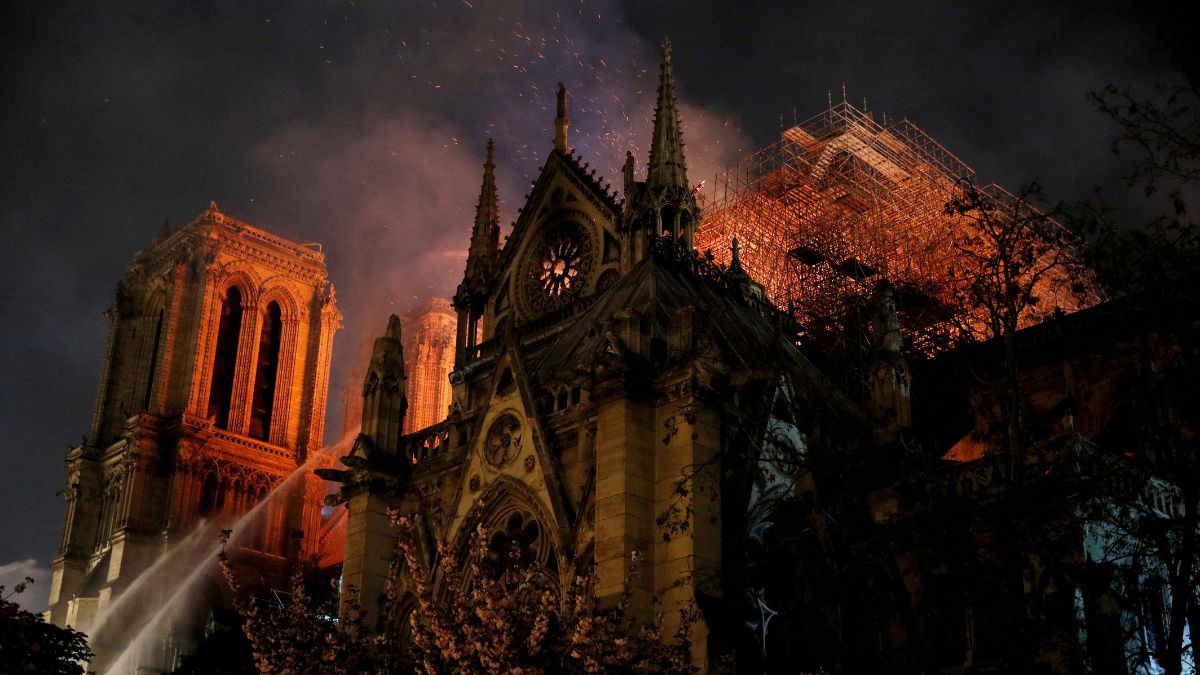The Notre-Dame de Paris, one of the most treasured symbols of French culture and faith, has risen from the devastation of a catastrophic fire in 2019. After an ambitious five-and-a-half-year restoration effort, the iconic cathedral is set to reopen
This Gothic masterpiece stands renewed, blending its medieval magnificence with careful modern updates. Its reconstruction captivated the world and became a testament to human resilience and ingenuity.
The night of April 15, 2019
In the early evening of April 15, 2019, disaster struck the heart of Paris. A fire erupted under the roof of the Notre-Dame, a structure constructed largely from ancient oak. Within minutes, flames engulfed the iconic wooden spire, causing it to collapse in a fiery spectacle that shocked onlookers around the globe .
As emergency services battled the inferno, the fate of the cathedral seemed grim. Yet, against all odds, the bell towers and façade were spared, thanks to heroic firefighters who risked everything to save them.
The tragedy was a poignant reminder of the cathedral’s centrality to French identity. President Emmanuel Macron declared the tragedy a “national wound,” calling for its restoration to be “more beautiful than ever.”
The fire, which may have been caused by an electrical fault or a burning cigarette, destroyed much of the structure but miraculously spared sacred relics, including Saint Denis and Saint Geneviève’s remains and a fragment of Christ’s Crown of Thorns.
These were rescued by emergency workers in a human chain and later restored to their place in the new spire’s rooster.
How Notre-Dame de Paris was rebuilt
Restoring Notre-Dame was no ordinary construction project. It required a blend of historical reverence, cutting-edge technology, and skilled craftsmanship to address the complex damage.
The French government set an ambitious timeline: the cathedral would reopen by December 2024. Despite initial scepticism, the project remained on schedule, thanks to the tireless efforts of over 1,000 artisans, engineers, and conservationists.
The first two years were dedicated solely to stabilising the fragile remains of the cathedral. This included erecting a protective scaffolding to prevent further collapse and meticulously removing debris.
Engineers reinforced the stone walls while preserving as much of the original structure as possible. Every detail was painstakingly documented, ensuring the restoration would stay true to Notre-Dame’s original design.
The restoration effort mobilised a network of nearly 250 workshops across France, employing specialists in traditional crafts.
These included carpenters, stonemasons, glassmakers, sculptors, scaffolders, and even organ builders. Their task was not only to repair but to replicate the artistry of centuries past.
Reuters quoted Stone-carver Samir Abbas who reflected on the scale of the project, describing it as “an exceptional renovation project.” Stonemasons laboured to restore the cathedral’s flying buttresses, rib vaulting, and iconic gargoyles.
Gilders painstakingly reapplied gold leaf to decorations, ensuring they shone as brightly as they did in the 13th century.
A centerpiece of the restoration was the reconstruction of the 19th-century spire designed by Eugène Viollet-le-Duc. Following Macron’s vision, the spire was rebuilt exactly as it had stood before the fire, with modern enhancements discreetly incorporated.
Inside the new spire, a golden rooster contains relics saved from the original: fragments of Saint Denis and Saint Geneviève’s remains and a piece of Christ’s Crown of Thorns.
In tribute to the late General Jean-Louis Georgelin, who oversaw the project until his untimely death in 2023, his name was engraved in the wood of the new spire, alongside a sealed document listing the 2,000 individuals who worked on the restoration.
Notre-Dame’s famed organ, the largest in France with 8,000 pipes and 115 stops, posed its own set of challenges. Each pipe was disassembled, cleaned, and meticulously reassembled, a process that took years. The organ will once again fill the cathedral with its majestic sound during the reopening ceremonies.
One of the most transformative aspects of the restoration has been the cleaning of the cathedral’s interior. Layers of soot and grime, accumulated over centuries, were removed from the stone walls, sculptures, and stained-glass windows. The result is a brighter and more vibrant space, revealing details unseen in living memory.
The restoration also addressed the side chapels, transforming them into a coherent narrative of the Catholic faith. These chapels will guide visitors through the Old Testament, the life of Christ, and the lives of saints, with explanations available via a multilingual smartphone app.
While the restoration adhered strictly to historical accuracy, it also embraced modernity. Macron commissioned contemporary artists to redesign six stained-glass windows on the southern side of the cathedral, ensuring that the 21st century would leave its mark on this historic structure.
The restoration of Notre-Dame was made possible by an outpouring of global support. More than 846 million euros ($928 million) were raised from 340,000 donors across 150 countries.
Wealthy patrons, including François-Henri Pinault and the Arnault family, contributed significant sums. Remarkably, the donations exceeded the project’s estimated cost of 700 million euros ($767 million), leaving funds for future investments in the cathedral.
A new chapter for Notre-Dame
The reconstruction of Notre-Dame goes beyond repairing a building; it celebrates the resilience of a cultural icon. As Macron noted during a soft-opening on Friday, “Never before have we seen such a construction site. You all had your share in the project of the century.”
The cathedral’s reopening will feature a ceremony on December 7, 2024, with Macron, Paris’ Archbishop Laurent Ulrich, and other dignitaries in attendance. The event will include the traditional knocking on the cathedral doors, a blessing of the organ, and an inaugural Mass.
Notre-Dame is expected to welcome 14 to 15 million visitors annually. While admission remains free, visitors will need to book tickets online to manage the anticipated demand. Religious groups and guided tourist groups will gain access starting in early 2025.
The cathedral has witnessed eight centuries of French history.
As Parisians prepare to welcome the world back to Notre-Dame, Archbishop Ulrich said in a message: “We are very eager to welcome the whole world under the roof of our cathedral.”
With inputs from agencies
)